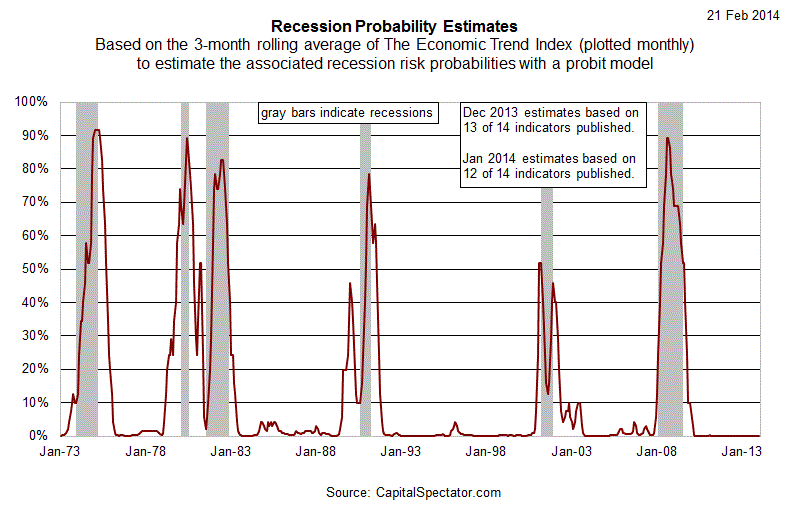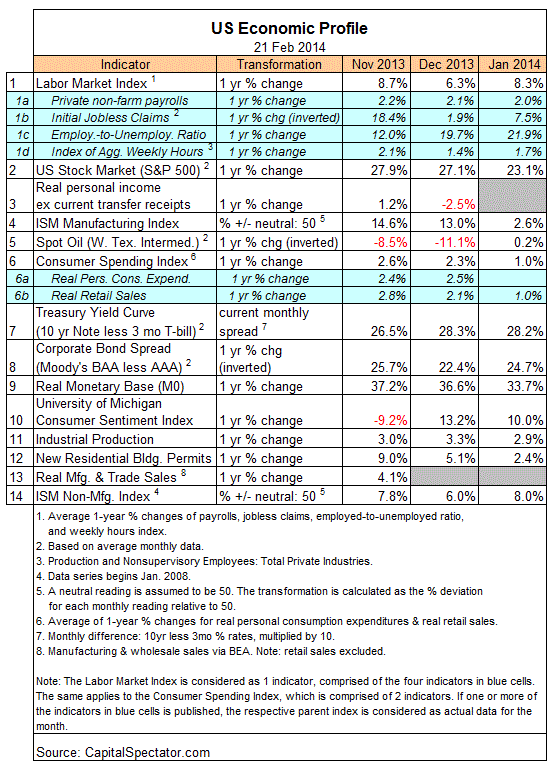The economic news for the US has been disappointing in recent weeks, although yesterday’s updates on jobless claims and the manufacturing sector offer a brighter view. Nonetheless, it’s easy to assume that the business cycle is faltering, based on weak numbers for housing starts, retail sales, payrolls and personal income in the latest releases. But when you step back and consider the broad trend based primarily on year-over-year changes, there’s still no overt sign that the economy is deteriorating. A diversified set of 14 economic and financial indicators still point toward growth. This view via the data offers yet another reminder that it’s dangerous to draw hard and fast conclusions about the state of macro from a handful of numbers using monthly comparisons.
The January profile of the US Economic Trend and Momentum indices (ETI and EMI, respectively) remain at levels that equate with growth and the near-term projections for the months ahead suggest more of the same. This can change, of course, depending on what the updates reveal in the weeks ahead. But the existing data sets collectively suggest that the economy is still poised to expand in the immediate future. When and if this changes in a convincing way, you’ll read about it here.
Meantime, the nearly complete set of January numbers are uniformly positive. That said, there are some weak spots that deserve close attention. In particular, the deceleration in the growth rate for real retail sales in this year’s first month may be a sign of future trouble. Ditto for the sharp slowdown in the growth of newly issued building permits. But for the moment, the big picture for January remains firmly skewed toward growth.
Now let’s turn to a composite measure of the 14 indicators in the table above via ETI and EMI (see chart below for definitions). Reviewing these business cycle metrics across history shows that both benchmarks remain well above their respective danger zones: 50% for ETI and 0% for EMI. If and when these indexes fall below those tipping points, we’ll have clear warnings signs that recession risk is elevated.
Translating ETI’s historical values into recession-risk probabilities via a probit model also suggests that business cycle risk is low.
 For some perspective on how ETI’s values may evolve as new data is published in the near future, let’s review projections for this index with an econometric technique known as an autoregressive integrated moving average (ARIMA) model, based on calculations via the “forecast” package for R, a statistical software environment. The ARIMA model estimates the missing data points for each indicator, for each month through March 2014. (November 2013 is currently the latest month with a complete set of published data). Based on today’s projections, ETI is expected to remain well above its danger zone in the near term.
For some perspective on how ETI’s values may evolve as new data is published in the near future, let’s review projections for this index with an econometric technique known as an autoregressive integrated moving average (ARIMA) model, based on calculations via the “forecast” package for R, a statistical software environment. The ARIMA model estimates the missing data points for each indicator, for each month through March 2014. (November 2013 is currently the latest month with a complete set of published data). Based on today’s projections, ETI is expected to remain well above its danger zone in the near term.
Forecasts are always suspect, of course, but recent projections of ETI for the short-term future term have proven to be relatively reliable guesstimates vs. the full set of monthly reported numbers that followed. (That’s not surprising, given the broadly diversified nature of ETI. Predicting individual components, by contrast, is prone to far more uncertainty in the short run.) As such, the latest projections (the four pink bars on the right in the chart below) offer support for cautious optimism. For comparison, the chart below also includes ARIMA projections published on these pages in previous months, which you can compare with the complete monthly sets of actual data that followed, based on current numbers (red circles). The assumption here is that any one forecast is likely to be wrong, but the errors may cancel one another out to some degree by aggregating a broad set of forecasts into ETI.
For additional context for judging the value of the forecasts, here are previously published ETI and EMI updates for the last three months:



Can you please report what the readinngs for EMI and ETI were for January?
Thank you.
January 2014 ETI: 90.1%
January 2014 EMI: 7.5%
Pingback: Jobless Claims Slide To 3-Month Low
Pingback: US Economic Profile
Pingback: A Return To Trend With Payrolls